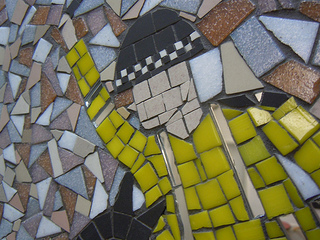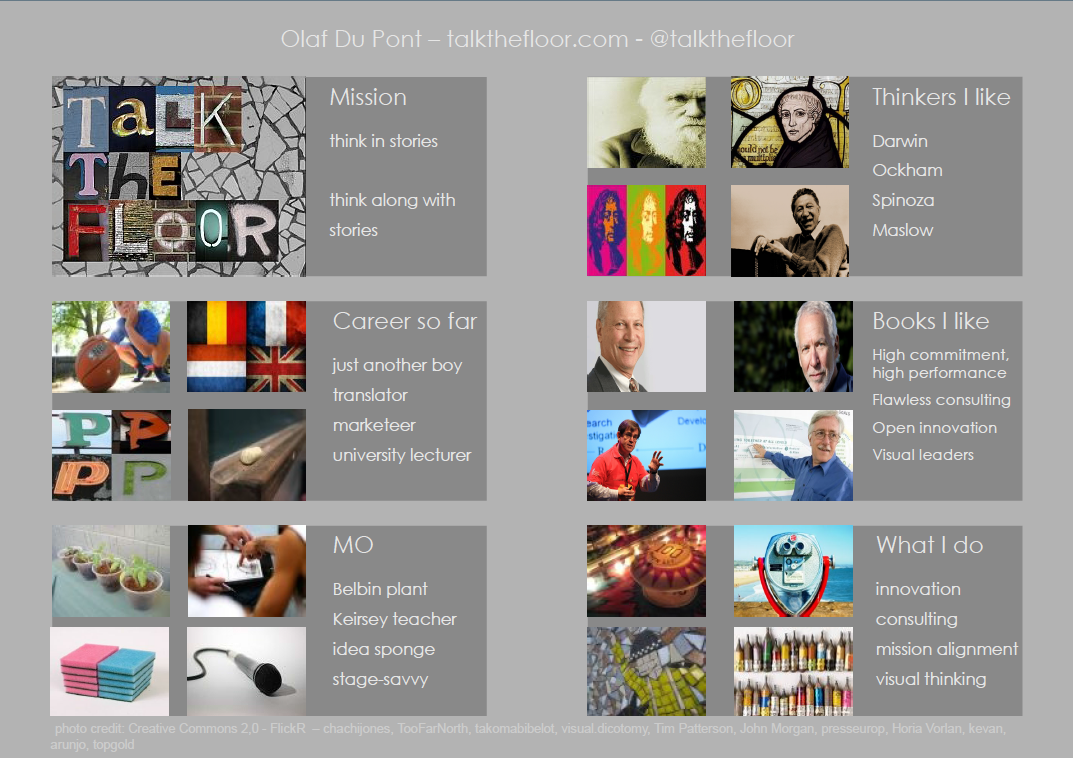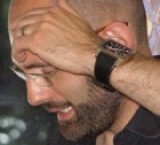A MissionMosaic mixes individual stories of staff which mirror a mission value into a coherent whole. When thinking up stories for the MissionMosaic, staff are encouraged to rethink their work processes. This results in aligned workers who innovate their work processes bottom-up. Practical, low-threshold and NO FLUFF.
Every organization wants more commitment; every organization wants better process innovation. It's the getting there that remains a human thing, and consequently it's a blurred and messy affair.
"If building and sustaining a high commitment, high performance organization were easy, everyone would be doing it." – Michael Beer, Harvard Business School
"... the need for process innovation is just as crucial as the need for innovative products." - Affiliated Engineers
With a MissionMosaic, you take the soul of an organization, its mission, and get it as close to individual staff and others in the ecosystem as possible.
To get under their skin, you first have to live with staff through participant observation to find out what range of values and cultures flourish in the various levels, silos, departments and teams within the organization.
Then it's time to compare: where do the various cultures overlap and where do they show wide gaps with the central mission.
In a crucial third phase, it's time to 'talk the floor' and engage in co-creating stories that align with the mission. It's important here to incorporate situations, logic and background of the specific site into the stories to remain relevant to staff.
That's why the observer of the first phase should become a facilitator in the third phase and help staff come up with new ways of looking at their work through role-playing, storyboarding and other narrative techniques.
This process can lead to a bottom-up re-examination of how the work is carried out in the first place. In other words, an open look and the opportunity to be listened to about their own responsibilities, offers staff a white canvas to sketch new options, aligned to the mission.
More alignment can create the windfall of more process innovation, and consequently new performance measures and rethinking incentives. They act as internal consultants to management. Afterall, the essence of being a consultant is creating influence and guiding because they lack formal power to implement themselves.
Staff can more readily relate to other staff's work when they see it framed in a story that builds on a common value. Hearing or reading about experiences that ring true can promote silo-busting initiatives and create a common language between groups as different as babyboom-engineers and millennial-marketeers.
In addition, the wealth of stories offers a prime source of communication opportunities, both inside and outside the company.
In short, a MissionMosaic replaces the top-down monolith mission that lives only on a webpage and in C-suites with a mosaic of aligned and lived corporate stories.
Low threshold: creating a MissionMosaic requires no special software or technologies, no specific training of staff, nor management, although their experiences and insight into values can have a lastinng impact on the way they work and communicate.
No new paradigm or parallel structures: although the process of sharing stories about common values can spark process (and other) innovation, the process itself does not require new structures, nor the use of an entirely new management jargon.
The scalable nature of the effort allows quick trialling and first results (in small team settings) within a quarter.
Commitment and coherence within teams increase, as across teams and departments. Being co-authors of a story means signing off together.
Staff have a common frame of reference for making decisions and opening communication with other 'sites', both inside and outside the organization. Staff may say things like: 'Solution A may be more efficient but it goes counter our central value of...'
Awareness of 'the bigger picture' increases and can spark new initiatives. 'Let's contact the people over at Y to collaborate on this. I met with their C?O and they also value ??? above all.'
Staff question themselves and their work through a more uniform lens, yet the separate nature of each work site remains valued.
Corporate communication is more relevant to staff.
Line managers can borrow from the various stories to identify best practices and HR can use them to devise new incentive schemes.
Line managers and senior management can identify ways to quantify more intangible performance measures in new ways that they hadn't considered before.
Staff become mission ambassadors.
Challenges abound
It just sounds too simple to work: listening to people and helping them finetune meaningful anecdotes creates such ROI? And alignment? And a better work environment? And the perfect storm of momentum joinging forces with commonly shared process innovation? Why didn't any one else do this much earlier then? Well, people are already doing it. With success. I refer to the sources below. The majority don't, however. Lack of time? Thinking other stuff has priority? Too busy 'managing', there's no time left to 'promote'? Preferring a cv that says 'managed 5$m budget' over one that states 'weekly mission walks across divisions'?
Of course, who would prefer silly things as 'stories' over numbers. Counting is safe. Measuring alignment is fluid. It will take numbers on the success of aligned companies to get the quants at the top on board.
Alignment ROI is spread over so many aspects (less absenteeism, more productivity, more initiatives...) that it might be tempting to dismiss its influence and attribute gains to other variables.
Mission alignment will take a lot of time in silo organizations where a wide range of closed-off subcultures have so deeply rooted that stories from other departments need to erode a very thick wall to penetrate. The Grand Canyons of mission alignment.
It will take a lot of 'boots on the ground'. Participant observation in phase one and thorough story building in phase three take time and require skilled corporate anthropologists to do the job. During this time no immediate ROI is noted.
Finally, the C-suite may be forced to reconsider the core mission in the first place. Could be a rude awakening for some.
Just start walking. But first some preconditions, a description of the MO to adopt and a word about scaling:
Precondition 1. C-level has to sign off on the (a) mission
Precondition 2. A corporate anthropologist should talk to the people at the top about their take on the mission. Subcultures may lurk there too.
Precondition 3. no hidden agendas when entering the field, analysis will not be used for individual HR assessments nor for incentive or employment decisions
MO. A single corporate anthropologist can start at a single team/site and go through the four initial phases and guide follow-up:
Phase 1. walking the floor: mapping existing cultures & values in the ecosystem; preferably with managers and Cs regularly in tow.
Phase 2. mapping culture gaps and feeding back to the manager(s) and staff involved to identify process issues,
Phase 3. talking the floor: equipped with insight in starting culture and target culture, talking openly, using narrative techniques to make abstract values and ideas concrete. Channelling and framing suggestions for process innovation where required.
Phase 4. aggregating, visualising and framing the stories in a coherent whole. Then, collaborate with management and communication to choose messages and media to communicate the stories and the mosaic within the ecosystem to reinforce the mission values and incite action along those lines
Follow-up: two extra phases
Phase 1. bottom-up management suggestions are discussed within the mosaic framework (operations, HR). Preferably level talks; neither bottom-up nor top-down, but people from different tiles talking 'level'
Phase 2. ensuing innovation efforts can be incubated and guided by staff
Scaling. On the basis of the small case-study, the effort can be scaled up to more sites/teams.
Thanks to the magnificent people at the site where MissionMosaic took shape in my head: the teaching and administrative team at 'De Step', a private school founded and run by parents to teach experience-based primary education at two different sites in Antwerp, Belgium. To tackle a negative accreditation report, we rallied as members of the Board and took another look at the mission, which was longish and very, very fluffy to the degree that it became without focus. What followed was that we gathered a sample of workers from the inside, but also invited outsiders to talk from scratch. This made us cut down hundreds and hundreds of words of text to five three-word slogans. These slogans served for in-team talks and yielded stories that engendered enthusiasm, focus and a wealth of exchange in best practice and ideas for tackling situations differently. I saw a MissionMosaic unfold before my eyes, but didn't realize that at the time. De Step is now a fully accredited school, just as vibrant as before, but more in step.
Thanks to my thesis student at Ghent University, Anke Schauwaert, for taking the courageous decision to identify mission gaps in a 'serial-startup-gone-cluster' company. Job well done. Likewise to the C-levels at the company for being open when hearing the outcome of the research and trying to work with it.
Thanks to people sharing online and putting up material with a CreativeCommons license: it does more than bring my ideas to life: it gives life to new combinations and new ideas. Special thanks for mosaic posters which sparked the concept.
Video first
Steve Jobs's graduation speech at Stanford is fast becoming an evergreen in the genre. His approach: "Just three stories. That's it". In other words, Steve's personal MissionMosaic. Thanks to the internet, the three tiles of that mosaic continue to inspire millions around the world. And everyone at Apple.
More charisma on stage with Simon Sinek, advocating walking & talking the floor beautifully at [2.00]: "For those few [organizations] that have that combination of things, the clarity of vision, the discipline of how they're going to do it -the structure- that beautiful partnership and making sure that everytinh they say, everything they do, proves it so that those in the outside world can clearly understand it as clearly as they can. When they have that beautiful combination; it grows."
Followed by a CEO who actually does it... and reaps the fruits, Murray Jordan of New Zealand's Foodstuff.
The reads
The gist of Michael Beer's plea for a multistakeholder holder, in which psychological alignment [mission alignment] is a crucial precondition.
Big-data expert Tom Davenport (a quant!) asking for more anthropology back in 2007.
Finally, researchers show that processes can sometimes not be standardized and that employees on the floor should be empowered, with a case of values that were revisited and changed from practical imperatives to guidelines that can be implemented with a personal touch.
The images
I'm sure you'll figure it out yourselves.
Enjoy and I hope it connects with something you bring to the table.
Olaf



Extremely well documented and very smart lead and design.
You are clearly working and experimenting on the right spots and opening new doors.
Very inspiring.
- Log in to post comments




You need to register in order to submit a comment.